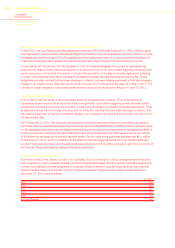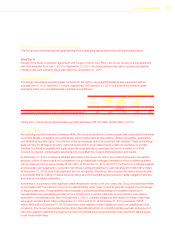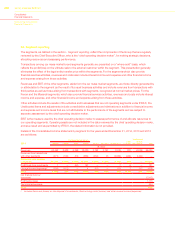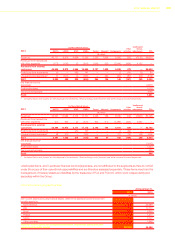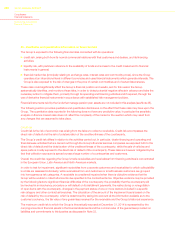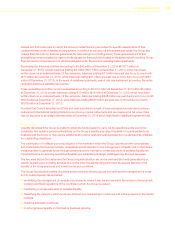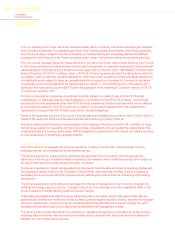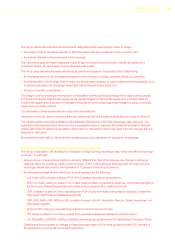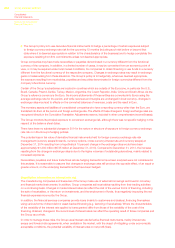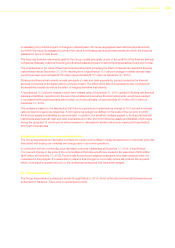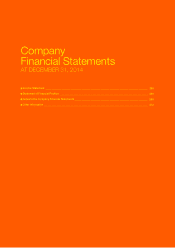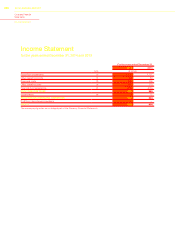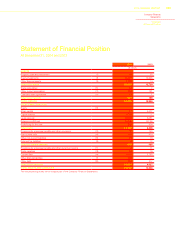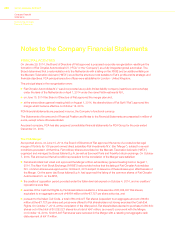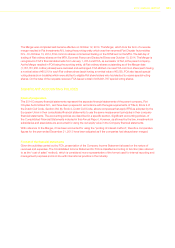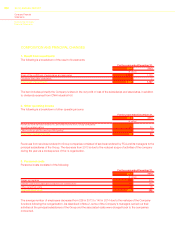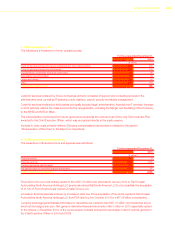Chrysler 2014 Annual Report Download - page 256
Download and view the complete annual report
Please find page 256 of the 2014 Chrysler annual report below. You can navigate through the pages in the report by either clicking on the pages listed below, or by using the keyword search tool below to find specific information within the annual report.
254 2014 | ANNUAL REPORT
Consolidated
Financial Statements
Notes to the Consolidated
Financial Statements
The Group’s policy is to use derivative financial instruments to hedge a percentage of certain exposures subject
to foreign currency exchange rate risk for the upcoming 12 months (including such risk before or beyond that
date where it is deemed appropriate in relation to the characteristics of the business) and to hedge completely the
exposure resulting from firm commitments unless not deemed appropriate.
Group companies may have trade receivables or payables denominated in a currency different from the functional
currency of the company. In addition, in a limited number of cases, it may be convenient from an economic point of
view, or it may be required under local market conditions, for companies to obtain financing or use funds in a currency
different from the functional currency of the respective company. Changes in exchange rates may result in exchange
gains or losses arising from these situations. The Group’s policy is to hedge fully, whenever deemed appropriate,
the exposure resulting from receivables, payables and securities denominated in foreign currencies different from the
company’s functional currency.
Certain of the Group’s subsidiaries are located in countries which are outside of the Eurozone, in particular the U.S.,
Brazil, Canada, Poland, Serbia, Turkey, Mexico, Argentina, the Czech Republic, India, China and South Africa. As the
Group’s reference currency is the Euro, the income statements of those entities are converted into Euros using the
average exchange rate for the period, and while revenues and margins are unchanged in local currency, changes in
exchange rates may lead to effects on the converted balances of revenues, costs and the result in Euro.
The monetary assets and liabilities of consolidated companies who have a reporting currency other than the Euro, are
translated into Euro at the period-end foreign exchange rate. The effects of these changes in foreign exchange rates are
recognized directly in the Cumulative Translation Adjustments reserve, included in other comprehensive income/(losses).
The Group monitors its principal exposure to conversion exchange risk, although there was no specific hedging in this
respect at the balance sheet dates.
There have been no substantial changes in 2014 in the nature or structure of exposure to foreign currency exchange
rate risk or in the Group’s hedging policies.
The potential loss in fair value of derivative financial instruments held for foreign currency exchange rate risk
management (currency swaps/forwards, currency options, cross-currency interest rate and currency swaps) at
December 31, 2014 resulting from a hypothetical 10 percent change in the exchange rates would have been
approximately €1,402 million (€745 million at December 31, 2013). Compared to December 31, 2013, the increase
resulting from the change in exchange rates is due to the higher volumes of outstanding derivatives, mainly related to
increased exposures.
Receivables, payables and future trade flows whose hedging transactions have been analyzed were not considered in
this analysis. It is reasonable to assume that changes in exchange rates will produce the opposite effect, of an equal or
greater amount, on the underlying transactions that have been hedged.
Quantitative information on interest rate risk
The manufacturing companies and treasuries of the Group make use of external borrowings and invest in monetary
and financial market instruments. In addition, Group companies sell receivables resulting from their trading activities
on a continuing basis. Changes in market interest rates can affect the cost of the various forms of financing, including
the sale of receivables, or the return on investments, and the employment of funds, thus negatively impacting the net
financial expenses incurred by the Group.
In addition, the financial services companies provide loans (mainly to customers and dealers), financing themselves
using various forms of direct debt or asset-backed financing (e.g. factoring of receivables). Where the characteristics
of the variability of the interest rate applied to loans granted differ from those of the variability of the cost of the
financing obtained, changes in the current level of interest rates can affect the operating result of those companies and
the Group as a whole.
In order to manage these risks, the Group uses interest rate derivative financial instruments, mainly interest rate
swaps and forward rate agreements, when available in the market, with the object of mitigating, under economically
acceptable conditions, the potential variability of interest rates on net profit/(loss).




